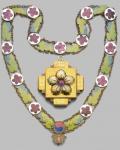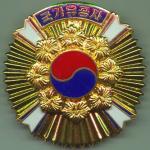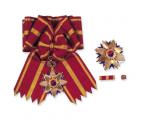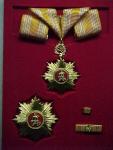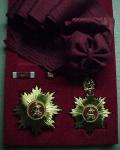
Dfifer
Past Contributor-
Posts
46 -
Joined
-
Last visited
Content Type
Profiles
Forums
Blogs
Gallery
Events
Store
Everything posted by Dfifer
-
According to the Koreans, there was a total of 60 Orders of the Plum Blossom issued, not counting those issued to the Royal Family. 1902 ? 2 1904 ? 5 1905 ? 6 1906 ? 6 1907 ? 10 1908 ? 16 1909 ? 4 1910 ? 11
-
Grand Order of Mugunhwa Issued from 1949 to 1967. The pendant is described as 87mm by 82mm with the Mugunghwa flower being 58mm across and the Taeguk symbol having a diameter of 10mm. The Order is made of gold with silver being used to accent the Mugunghwa flowers along the length of the chain. The flowers on the chain represent each of the provinces and the cities of Seoul and Pusan which have provincial statue. Minor variations are known to exist. The other style issued after 1967 has been changed several times. Today the Gold version is issued in either a male or a female size for Heads of State, while the Silver version is issued in either a male or a female size for the spouses of Heads of State.
-
Hugh, I have another name and answer for you. National Merited Persons Medal Awarded to A patriot awarded the Order of Merit for National Foundation, the National Foundation Merit Medal, or the President's Commendation for National Foundation, in appreciation of meritorious deeds performed in the Independence Movement against the Japanese colonial rule.A veteran who was killed or who was disabled in a combat action, such as the Korean War, the Vietnam War, during military training, or in the performance of their duty.A person who was awarded the Order of Military Merit, or National Security Merit, in appreciation of exceptional efforts to protect national security in war or in peacetime.A veteran, who had been living in Japan, and who, volunteered and participated in, the Korean War between Jun. 25, 1950 and July 27, 1953.A person who participated in and was killed or died or was disabled in the revolution that occurred around Apr. 19, 1960, or who was awarded the National Foundation Medal.A person who was disabled in the line of duty while serving in a national or local government office.A person who is determined to have been killed or wounded during the performance of distinguished service or someone who is determined to have been a special contributor to national and social development. Special determinations for this type of compensation are to be made at a cabinet council meeting.A policeman who was killed, died, or was disabled in combat, or during military training, or in the performance of his duty, and is retired from the service. This special dispensation is made for policemen who performed the same duties as servicemen during wartime. The MPVA considers such policemen to be veterans.Instuted in 1986 and discontinued in 2002.
-
Megan, On this Order of Diplomatic Service, 5th Class, 1st type, is there any chance you can get me a picture of the reverse. I am trying to determine if this is a 5th Class or a 6th Class. The original Korean Legislation is really strange. It says that the 5th class ribbon is green, red, white, red, green, but the ribbon bar is red, green, white, green, red. It says that the 6th class ribbon is red, green, white, green, red, but the ribbon bar is green, red, white, red, green. It's giving me a headache. Appreciate any help that you can give me. Thanks, Don
-
-
-
Not a problem, have at it. Don P.
-
Order of Service Merit, 4th Class. Issued from 1961 to 1967 Ribbon is heavily soiled, should be a 22mm yellow center stripe
-
I have heard of this happening several times before, but always because someone asked for a replacement for their missing/lost/damaged medal. The Korean government does not keep an inventory of the older styles. The General Douglas MacArthur Memorial in Norfolk, Virginia asked for an original replacement. But the price was so steep, that they decided not to buy it. (Interesting side note: When Douglas MacArthur was given the Order of Military Merit, First Class, the President of Korea,Syngman Rhee had to apologize for only having the document. The Medal did not make it to the ceremony in time. All of the available records and pictures give a very strong indication that Douglas MacArthur never did receive his medal.)
-
Korean War Era, Next of Kin Medal with original box I find this medal fascinating. At first glance you would think that it is the Japanese Next of Kin Medal. Korea was occupied by Japan from 1910 to the end of WWII. During WWII more than 240,000 Koreans were conscripted into the Japanese army and approx. 22,182 of them were killed in action. Hundreds of thousands of Koreans died in Japanese forced labor camps/factories. Approx. 70,000 Koreans were killed by the A bomb at Hiroshima. With all of the hatred that the Koreans had for the Japanese, you would think that they would have a completely different design, but they don't. The central design element is the Mugunghwa Flower.
-
Miniature medal group (Left to Right) Order of Military Merit, ChungMu Class w/Silver Star Order of Military Merit, ChungMu Class w/Silver Star Order of Military Merit, ChungMu Class w/o Star Order of Military Merit, Hwarang Class w/Silver Star Order of Military Merit, Hwarang Class w/Silver Star Order of Military Merit, Hwarang Class w/o Star United States Bronze Star Defense Merit Medal 10th Anniversary of the founding of the Korean Military Anti-Guerilla Warfare Service Medal Korean War Service Medal - Type 2 Red Cross Donation Medal, Silver Class United Nations Medal for Korea
-
-
KVA - Korean Veterans Association This medal was part of the Revisit Korea Campaign. Foreign veterans were invited back to Korea to see how far Korea has advanced since the war. What a lot of veterans never realized was that the buses, hotels, and some of the eating facilities were owned by the KVA.
-
-
-
This particular design was used from 1951 to 1963, at which time it went to a cravat and had a breast star added.
-
This design for the Taekuk was used from 1951 to 1963, at which time it was changed to a sash and had a breast star added.
-
This particular design for the Chungmu Class was issued from 1951 to 1963.
-
You are correct, The mugunghwa is the Rose of Sharon. It is a Hibiscus, that when cut down quickly grows back. By extension, Korean is a country that has often been invaded but always comes back.
-
<a name="_Toc183225618">Several people have asked if the Korean stuff is more confusing than the ROC awards. I would like to give some quick remarks to try and clear up some of the confusion, but I will probably muddy the field more than anything else. Some of the information that I am about to give, comes from the English language section of three books published by the Korean government (1958, 1963, 1968). All three books specifically deal with Korean Orders, Merit Medals and Presidential Citations. The specific details for all of the name changes, comes from Presidential Decree #2929. In 1951, Korea created the Order of the White Star in four classes, namely: Blue Stripes, Yellow Stripes, Red Stripes and Green Stripes. A fifth class named Aquamarine Stripes was instituted in 1963. In the 1958 and 1963 books, the Order of the White Star is listed as the Order of Civil Merit, and in both books, it states that the Order of Civil Merit is awarded to government employees, other than military personnel and civilian employees of military organizations, who distinguish themselves with outstanding meritorious services in the performance of their duties. In 1967, the Order of the White Star was renamed Order of Service Merit. The 1968 book states that the Order of Service Merit was to be awarded to government employees who had greatly contributed to the national development through their outstanding performance of duties. It specifically excluded the military and the civilian employees of the military. The various classes for the Order of Service Merit now had the names that were previously used on the Order of the White Star. Perhaps a better title for this Order would be the ?Order of Civil Service Merit?. In 1951, Korea established the Order of Cultural Merit in three classes (Republic of Korea Class, Presidential Class and National Class). In the 1958 book, it states that it was awarded: ?to Korean and foreign personnel in recognition of their outstandingly meritorious contributions to the fields of diplomatic service, military affairs, social relief, development of national economy, and other services rendered in the interest of the improvement of national welfare and productivity?. When it comes to the Order of Civil Merit in the 1968 book, it states: ?These shall be given to those who have rendered distinguished service in the field of politics, economy, social welfare, education, art, science, physical education or other culture, and have thus made distinguished contributions to the advancement of national welfare and to the prosperity of the nation?. In effect, it is an Order of Civilian Merit. In 1961, the government established the Order of Service Merit in seven classes, with no specific names for each of the classes only a number. It was awarded to those distinguishing themselves with outstanding meritorious service to the national safety and defense and was available to the military and government employees working for the military. In effect, it is a non combat military award. In 1967, it was renamed the Order of National Security Merit. In 1967, the Order of Cultural Merit ceased to exist. The name, Order of Cultural Merit was resurrected in 1973, with a completely different purpose. Since the original Order ceased to exist in 1967, the names used for the three classes were transferred to the Order of National Foundation. Other than the similarity of the class names, there is no connection between the two Orders. As a quick recap: In 1967, The original Order of the White Star (AKA Civil Merit) became the Order of Service Merit. The original Order of Service Merit became the Order of National Security Merit. The original Order of Cultural Merit became the Order of Civil Merit. The Order of Cultural Merit ceases to exist. The Classes for the Order of National Foundation are renamed. Believe it or not, this is just the tip of the iceberg.
-
I am not sure how much I can help with Korean ODM, but I can give it a try. There are more or less 5 general time frames for Korean ODM 1. Pre Korean war - There were a number of Korean Medals issued before the war, but very little is known about them. There were also two orders created, namely: the Grand Order of Mugunghwa and the Order of National Foundation. There were also 7 Merit Medals created. 2. From the Korean War to Park Chung Hee (1950-62). Most of these Orders and Medals are fairly straight forward. The one exception is the Order of Military Merit. Established in Oct. 1950 in 4 classes, in Dec. they expanded each class of the order into three separate grades with the addition of the Gold Star, Silver Star or No Star to the ribbon. The following April, they changed the ribbon colors and stripe pattern, and later that year they completely redesigned the Order. (Roughly 36 different awards) There are a couple more that I will cover when I eventually publish my book. I do not have time at the moment, but there are a couple of other comments that I need to make about the Order of Civil Merit. 3. Park Chung Hee the early years (1962-67). He created a number of new orders, and added a fifth class to several older orders. 4. 1967 - 1973 - this is without a doubt the most confusing area, names were changed, designs were changed, etc., etc. For instance the Order of Civil Merit became the Order of Service Merit, the design changed but the class names and the purpose for the Order remained the same. 5. 1973 to present. Korean settled down with eleven Orders and the designs have been fairly consistent ever since. There are some minor changes many of which are hard to discern. For instance the Order of Military Merit went from 180 rays of the sun to 184. You will find these on my website at http://home.earthlink.net/~dfifer/index.htm Some other tidbits Korea has issued at least: 15 different Red Cross Medals, 4 different wound medals (Prewar wound medal, two different plachets for the Standard Wound Medal and one for Permanent Disability) hundreds of diffent designs for their orders 40 different designs for the Merit Medals As soon as I have time, I will write more. If you have any particular questions, please feel free to ask. Don Pfeifer dfifer@earthlink.net

